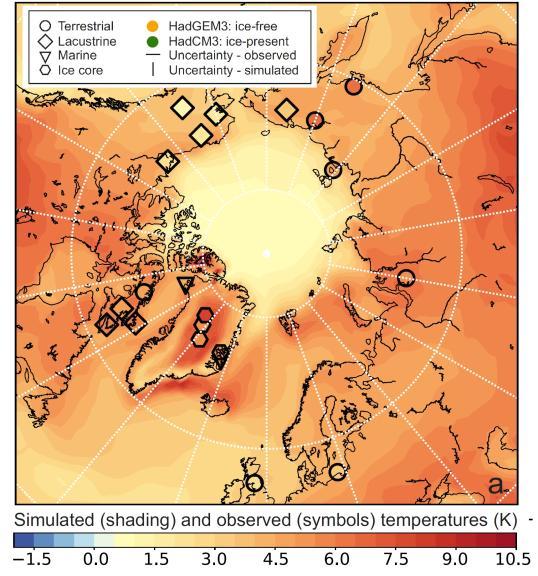
Lead supervisor: Louise Sime, British Antarctic Survey
Co-supervisor: Francesco Muschitiello, Geography; Matt Osman, Geography
Brief summary:
The Last Interglacial (LIG) period is probably the last time the Arctic experienced ice free summers, and a 4C warming. Until recently our climate models captured neither this warmth, nor the sea ice loss, nor the necessary feedbacks which drove this Arctic amplification of warmth. The project aims to resolve the drivers of Arctic Amplification.
Importance of the area of research concerned:
The Last Interglacial (LIG) period, which had higher summer solar insolation than today, is the last time that Arctic experienced ice free summers. During this time the Arctic was 3.7±1.5 K warmer than during the pre-industrial period (Sime et al. 2023).
until recently however our climate models captured neither this warmth, nor the sea ice loss, nor the necessary feedbacks which drove this Arctic amplification of warmth (Guarino and Sime et al. 2020). In 2013 the lack of LIG Arctic warmth in these models was thought to be due to a lack of dynamic vegetation feedbacks (Lunt et al. 2013; Otto-Bliesner et al. 2013; and IPCC AR5, 2013). In 2018 however, it was found that a sea ice-free summer in the Arctic might be partly responsible for signals of warming in Greenland ice cores (Malmierca and Sime et al. 2018). In 2020 the UK’s most important climate model accurately captured the warming for the first time (Guarino and Sime et al. 2020). This was due to sea ice, rather than vegetation, physics. The project aims will explore the relative important of all physical drivers of Arctic Amplification using a state-of-the-art Earth System Modelling approach.
Project summary :
After compiling Interglacial marine data (Kagayama and Sime et al. 2021) and temperature data (Sime et al. 2023), it was found that melt pond physics (albedo feedbacks) are sufficient to melt LIG sea ice and raise the Arctic temperature (Diamond and Sime et al. 2021), thereby giving a plausible match to observations (Sime et al. 2023). We are now learning more about melt pond physics, and how important these feedbacks are for the future projections, and are beginning to use LIG modelling to better parameterise our models (Diamond et al. in review). We nevertheless still lack knowledge about the other two possible drivers of LIG Arctic warmth. These are: (i) Arctic vegetation changes during warm periods and (ii) Arctic amplification due to water vapour feedbacks.
What will the student do?:
The student will use the brand new water tracer enabled UK Earth System Model (UKESM) to tackle these crucial outstanding questions. They will:
1. Run the UKESM model, with the new water/isotope tracers diagnostics, required to test these three hypotheses. They will set up, run and analysis LIG, and other, Interglacial sensitivity experiments run with carefully chosen sets of vegetation, sea ice, and vapour parameters.
2. Synthesis all necessary LIG Arctic data, developing the Sime et al. 2023 dataset, to ensure the consideration of all ice and marine core data. They will develop new Arctic: temperature, water isotope, and sea ice datasets for the LIG, and other, Interglacials.
3. They will use their new datasets, alongside their model simulations, to evaluate the sea ice, vegetation, and vapour hypotheses for Arctic amplification.
References - references should provide further reading about the project:
Sime, Louise C. , Sivankutty, Rahul, Malmierca Vallet, Irene , de Boer, Agatha M., Sicard, Marie. (2023) Summer surface air temperature proxies point to near-sea-ice-free conditions in the Arctic at 127 ka. Climate of the Past, 19. 883-900. 10.5194/cp-19-883-2023
Sime, L. , Malmierca, I. , Diamond, R., Schroeder, D.. (2022) Better forecasts of sea ice change? Melt puddles and melt models. Past Global Changes Horizons, 2. 38-40. 10.22498/pages.horiz.2.38
Diamond, Rachel, Sime, Louise C.,Schroeder, David, Guarino, Maria-Vittoria .
(2021) The contribution of melt ponds to enhanced Arctic sea-ice melt during the Last Interglacial. The Cryosphere, 15. 16 pp. 10.5194/tc-15-5099-2021
Kageyama, Masa, Sime, Louise C. et al. (2021) A multi-model CMIP6-PMIP4 study of Arctic sea ice at 127ka: Sea ice data compilation and model differences.
Climate of the Past, 17. 26 pp. 10.5194/cp-17-37-2021
Guarino, Maria Vittoria , Sime, Louise C. , Schröeder, David, Malmierca Vallet, Irene , Rosenblum, Erica, Ringer, Mark, Ridley, Jeff, Feltham, Danny, Bitz, Cecilia, Steig, Eric J., Wolff, Eric, Stroeve, Julienne, Sellar, Alistair. (2020) Sea-ice-free Arctic during the Last Interglacial supports fast future loss. Nature Climate Change, 10. 928-932. 10.1038/s41558-020-0865-2
Applying
You can find out about applying for this project on the British Antarctic Survey (BAS) page.